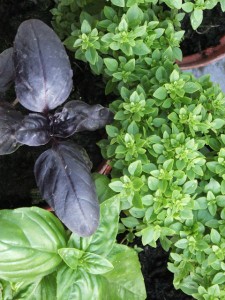Whereas many greenhouse plants are essentially decorative or useful basils may be both. Crucial fresh as an essential culinary herb a pot or several of basil can also be rather attractive especially the small leaved sorts. Indeed pots of manicured small leaved basil can substitute for box topiary during the summer. To be fair though most of the large leaf basils are not so neat though they still have lush foliage and the most gorgeous aromas that perfume the air when brushed past. (Basil flowers are pretty enough though small, but it’s better not to let basil flower as it remains useful longer, and neater, if kept cut hard back.) 
The original form of Sweet basil, Ocymum basilicum, arrived from the East at the start of the Elizabethan period. Originally the strong scent was employed for medicine more than in the kitchen, its name even means Kingly from its alleged healing powers. Basil was also added to chaplets and posies, probably to ward off ‘evil vapours’.
Its current popularity as a culinary herb began with the introduction of the tomato for basil is indispensable in most tomato dishes and sauces; indeed I believe there are few countries whose cuisine does not include basil in some dish or the other.
Most of all sweet basil has a flavour perfect with most Mediterranean dishes and especially with tomato salads. There are many varieties with minty, pepper-minty, lime, aniseed and lemony tones. It also comes in purple which some prefer for adding more colour to salads.
The small leaf form of sweet basil, O. minimum, was originally discovered in Chile and developed into numerous varieties in Italy. It is equally tasty and so much neater in appearance, but of course does not produce anywhere near as much material.
 There are other basils in the East including a Japanese sort, O. crispum, used for improving the colour and flavour of radishes, and the tender perennial, Holy or Sacred basil, which comes from India.
There are other basils in the East including a Japanese sort, O. crispum, used for improving the colour and flavour of radishes, and the tender perennial, Holy or Sacred basil, which comes from India.
Although you need a greenhouse or at least a warm propagator to start off basil from seed you can buy growing pots of Sweet basil from most supermarkets. These are small enough to sit on a sunny windowsill but tend to be short lived. Planting out or moving these up to larger pots seldom works well. But this is no great problem because basil is easiest grown, cropped and discarded rather than kept going for ever.
Sweet basil is a half hardy annual so with regular cutting back and feeding it could be sustained almost perpetually, but only if light levels and warmth permit. Inevitably basil flowers, seeds and dies or is killed by winter usually with grey mould finishing it off. Thus basil is best grown in several batches starting early each spring, used fresh and with any surplus taken and preserved for winter use.
Basil is best stored green, chopped and frozen in oil or ice cubes, or just frozen whole in a well-sealed tub for it loses flavour if dried. In really warm summers it could be planted outside- but there’s little point as under cover the foliage remains softer and so better flavoured.










